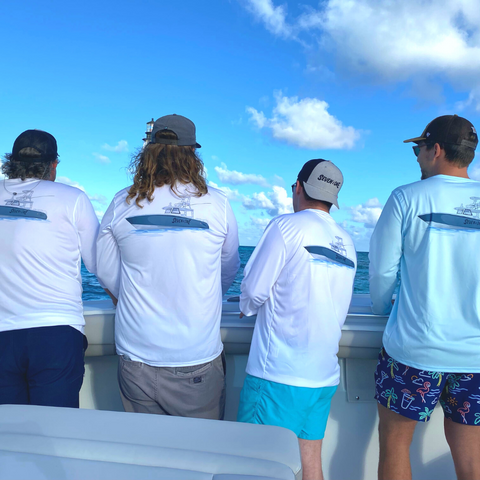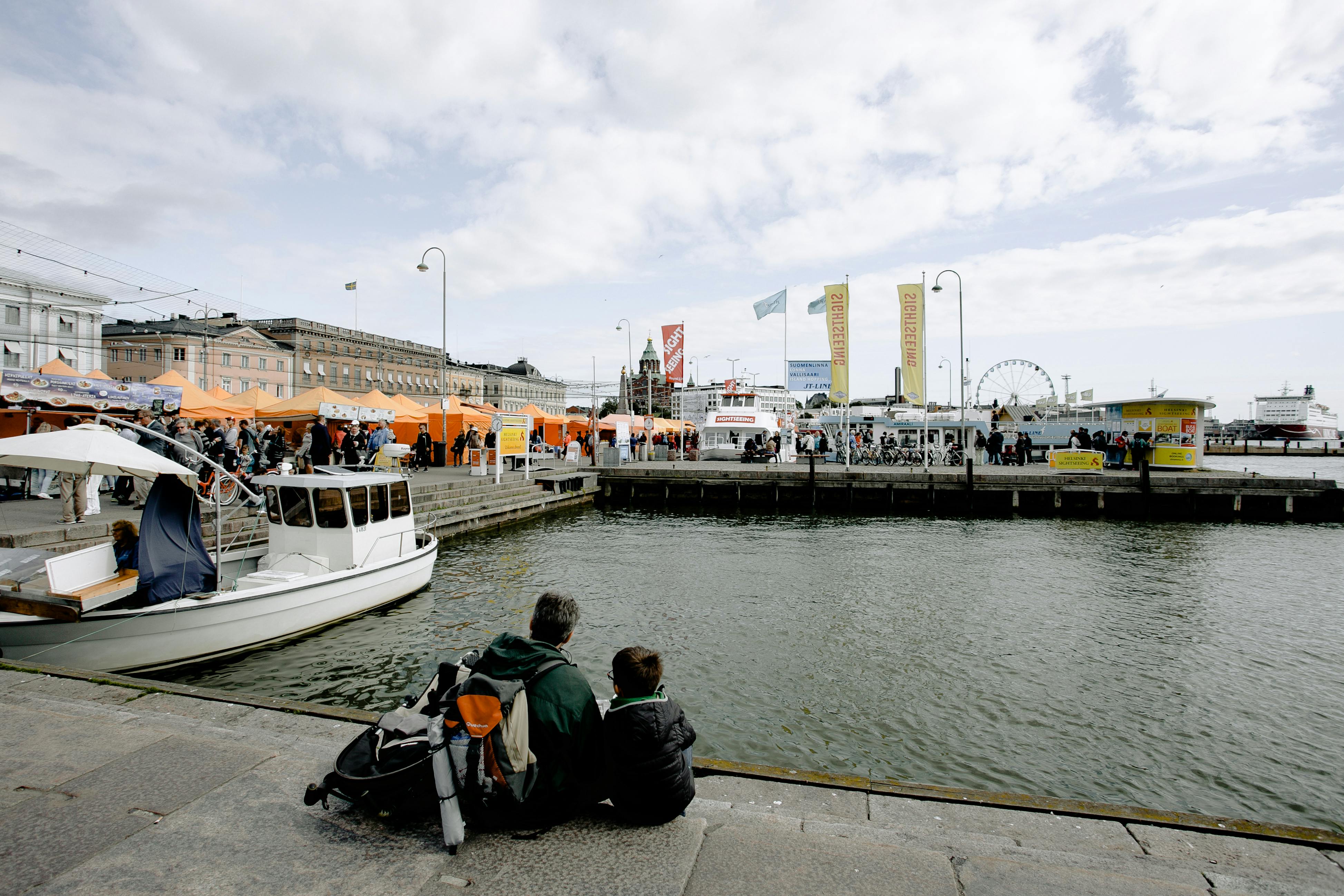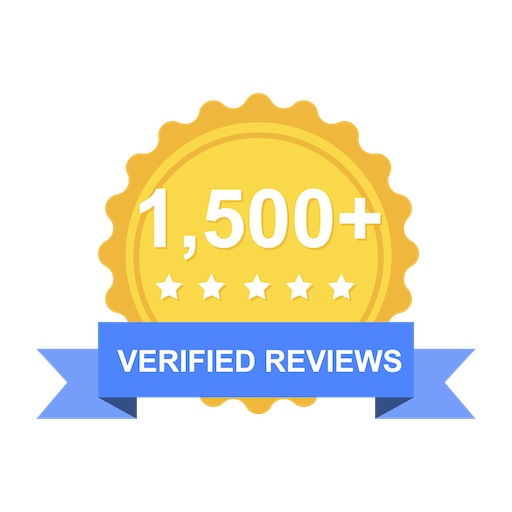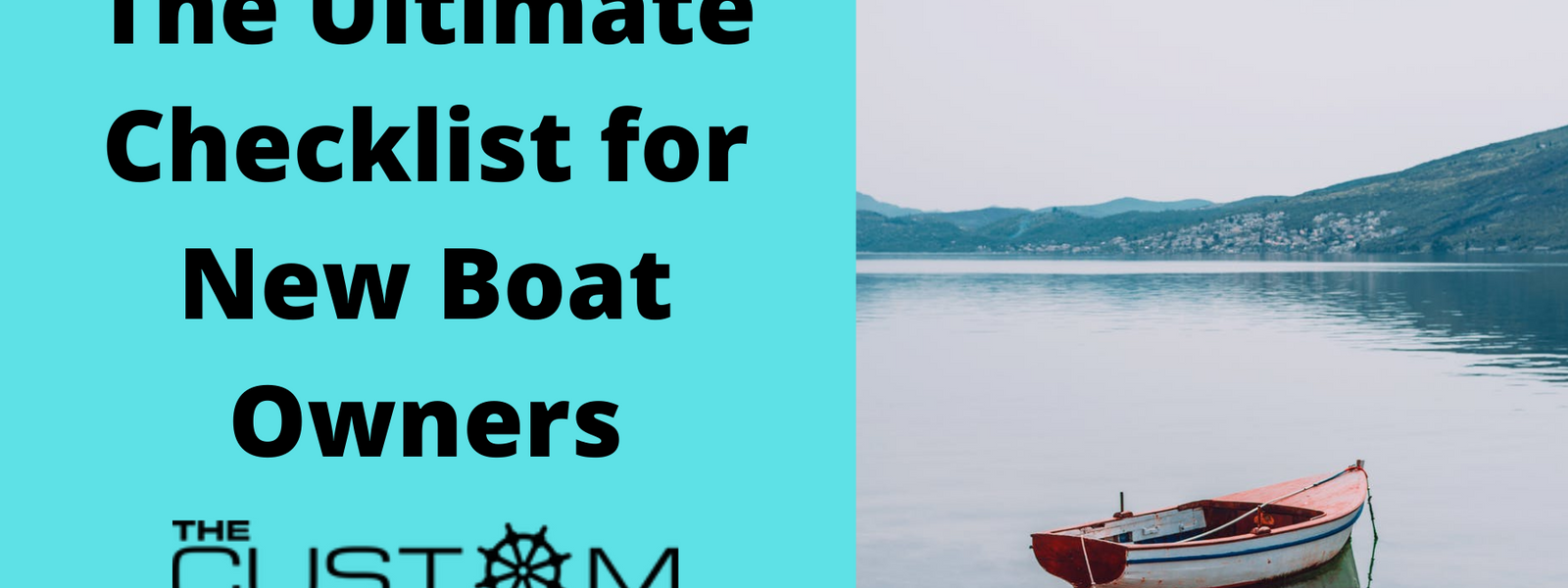You’ve bought a boat - now what?!
This crucial question is top of mind for any new boat owner. To make it easier for you, we’ve compiled a new boat owner checklist to prepare for your maiden voyage. From boating insurance to boating apparel, our guide for new boat owners wades through murky waters to identify the must-haves for new boaters.
With our guide as co-captain, you’ll be equipped with all of the things a new boat owner needs to not feel like a new boat owner.
What does every new boat owner need?
1) Boat Insurance.
For any new boat owner, it’s important to make sure you have the proper boat insurance to protect for both liability and boat damage. When shopping for insurance plans, it’s helpful to consult fellow boaters: ask them which insurance companies use, how their claims have been handled, and their experiences with boat insurance. For professional support, we recommend working with an insurance agent to ensure you’re getting adequate coverage. To begin, you need to know the two main types of boat insurance.
Types of Boat Insurance
- Agreed Value Policy: This covers the boat based on its value when the policy was written. It is preferred among boaters who need more coverage and/or want to know exactly how much they receive if an accident occurs. Agreed Value costs more initially but spares a new owner from depreciation costs.
- Actual Cash Value Policy: This costs less up front but factors in depreciation and boat wear to calculate its actual value at the time of loss.
- This is usually easier to obtain than an Agreed Value policy, but new boat owners will not know exactly how much the insurance company will pay until after the appraisal.
How much does boat insurance cost?
That depends when you consider these boat insurance cost factors:
- Where you boat
- Whether you have formal boating safety education
- Your boating and driving records
- Size and model of your boat
- Any specific equipment that may need specialized coverage
- Coverage levels depending on type of boat storage and regional weather concerns
2) Important Boat Documents.
Get Your Boating License
Depending on your state, you may need to take a state-approved boater education course before operating your new boat. You can learn how to obtain your state boating license on the DMV website. While many states require a license before hitting the water, others such as Tennessee, Texas and Washington mandate a state-approved boater’s safety course instead of a formal license.- For new and/or younger boaters, a supplemental boating safety course is always beneficial! The U.S. Coast Guard Auxiliary offers an extensive guide to local boating safety courses.
Where do you get boat registration?
New boat owners have to register their vessel and follow state laws regarding boat titling and operation. You’ll need to keep a Certificate of Title onboard at all times to prove your ownership. Like boating licenses, requirements for boat registration vary state-by-state: the DMV offers detailed information for each U.S. state to keep your vessel legally afloat.

3) Custom Boating Gear For Your Entire Crew.
You can’t leave the shore without proper boating apparel! In the Custom Captain merchandise store, you'll find everything a new boat owner needs: dri-fit shirts, tumblers, hats, dock mats, mugs, and other high-quality items, all of which can be printed with a custom drawing of your new boat.
Simply snap a photo of your newly purchased and cleaned (and registered!) boat - then send it our way. Our artists will transform your boat photo into an accurate line drawing that can be printed on a variety of apparel for your entire crew to sport.

New Boat Owner Checklist
After you have the things a new boat owner needs, consult our handy checklist with essential tips for new boat owners.
1) Learn to trailer and tow your boat.
Trailering allows you to visit new bodies of water and affordably store your boat. That said, it can be a nerve-wracking experience for new boat owners - but with practice and patience, you can transport your new boat with confidence and ease.

In addition to your personal research, we recommend working with a trusted boat dealer to make sure you’re purchasing the appropriate trailer for your boat, vehicle, and lifestyle. The most common types of boat trailers include:
- Bunk trailers: Very common and structurally simple, intended for smaller boats under 6 meters long.
- Roller trailers: Ideal for launching boats in shallow water (pay attention to the tides!).
- Float-on trailers: Perfect for larger boats that are too hefty to pull or lift into the water. With a float-on, you can gently float and submerge your boat into the water.
- While not technically trailers, keel rollers function similarly: these are placed in the center of a trailer to support a boat’s keel, the strongest part of a boat. This is crucial for aluminum boats which are easily damaged without proper keel support.
How To Tow a Boat

Towing a boat is typically less complicated than loading and retrieving it in the water. Still, boating experts highly recommend practice, practice, and more practice before trailering your boat on the road. Boat towers-to-be, take note!
- This handy video offers key safety tips to prevent trailer swaying, balance your trailer load, and generally avoid new boat owner mistakes. Check out the accompanying 10-item checklist for successful towing, as well as this list of U.S. state towing laws.
- Make sure that your vehicle is qualified to tow your new boat! Confirm the Gross Combined Vehicle Rating (GVCR), or the weight limit for the combined vehicle, loaded trailer, people, fuel, and gear. The trailer hitch should be rated for the weight of the boat and trailer; both the maximum tow rating and the GVCR are included in the owner’s manual.
- There are five classes of hitch for trucks, SUVs, and heavier tows, each of which accommodates a different gross trailer weight (GTW) and tongue weight.
- Before coupling your new boat to the trailer, complete a pre-tow inspection. Check for adequate tire pressure, functional brakes, and no loose gear that could fall out on the highway.
- When you’re ready to remove the trailer, check the trailer wheels for pressure and/or other concerns before uncoupling the trailer from the tow vehicle.
2) Practice the launch and retrieval of your new boat.

Learning how to back and launch a boat off the ramp is one of the most essential and stressful parts of being a new boat owner. To keep you safe (and other boaters happy), we recommend the following:
- Pretend that you’re fifteen and learning how to drive: boaters recommend going a few times during off-hours to practice backing down the ramp and launching.
- Study boat ramp etiquette to ensure a quick and easy transition for all boaters from the ramp to the water.
- At the marina, prepare in the staging area away from the launching ramp: check that the drain plug is installed and that your key is in ignition.
- When you’re ready to launch, aim to move slowly and straight down the ramp. A helper is highly recommended for boat launching: they can help hold the bow line, give the boat a push, and power the boat away from the launch ramp.
- For visual learners, check out this launching video for a step-by-step overview of boat launching.
- When you’re ready to return to land, this video offers an excellent overview of boat retrieval. When loading your boat, take this pro boater’s #1 tip: don’t back your trailer too far into the water!
3) Decide where to store your boat.
Especially for new boaters, it’s easy to overlook the logistics of boat care during the off-season. Storage is a #1 priority: some community permits prohibit long-term parking of boats in residential driveways, so you may need to consider creative storage options.
- If you have a large garage or money to spare, dry indoor storage offers the most protection. If you opt for commercial indoor storage (also called dry stack facilities or boatels), this is typically the most expensive storage option.
- In-water storage is possible in states with mild winters. This storage option may require winterization, which we’ll explore below in #4.
- A boat or dock slip is a single parking space for your boat. They’re easy to pull into and enclosed on 3 sides, preventing your boat from bumping and grinding against the edge of a dock.
- Standard dock slips in U.S. marinas range from $12-$50 / foot per year; prime U.S. locations can cost as much as $240/ foot per year. To find a marina near you, we recommend a quick Google Maps search in your area. You can even use this crowdsourced boat slip map to help boat owners find, lease and sublease boat slips & moorings.
- Dry outdoor storage can be found at your local marina, boatyard, or fenced lot. This is the most economical option and therefore the most common!

4) Schedule regular recommended boat maintenance.
Checklists are a new boater’s best friend. Even when your boat is stowed away for the winter, we recommend a maintenance checklist to complete regular oil changes, propeller inspections, and cleanings, among other basic boat to-do’s.
One of the most crucial forms of maintenance is keeping a clean boat. When detailing your boat, focus on:- A good rinse! As a new boat owner, you get to enjoy the satisfaction of a power wash on grimy boat exterior.
- Soaping and scrubbing the hull with a quality boat hull soap and brush.
- For interior surfaces such as carpet, fiberglass, vinyl, and cushions. experts recommend a variety of homemade cleaning solutions including vinegar-water solutions for marine heads and gentle soapy water for vinyl cushions. Marine carpets may require a vigorous scrub with a stiff-bristle brush soap, and water.
- Wipe it all down and finish with a marine polish and wax.
As a busy boater, you may occasionally opt for a professional boat detailing to maintain your new boat.
How to Winterize a Boat
- Prepping your engine (draining all water and applying corrosion protection),
- Adding a fuel-stabilizing additive to your fuel system and antifreeze to the plumbing system
- Removing drain plugs.
5) Stock up on basic safety and emergency boat equipment.

A new boat owner starter kit must include safety devices to protect you and your crew. Before you hit the seas, be sure to compile the following safety equipment:
- A pre-departure checklist to share with family or friends ashore. This includes key information such as safety checks, a weather forecast check, and filing a float plan.
- Life jackets (also called personal flotation devices or PFDs), which are required for everyone on board.
- At least one throwable flotation device to toss if a crew member is struggling in the water.
In the case of a boating emergency, you may also need:
- Visual signaling devices such as flares and sound signaling devices such as air horns and whistles, which are especially effective in fog.
- Check distress signal requirements based on your state and vessel size.
- A Personal Locator Beacon or Emergency Position-Indicating Radio Beacon (EPIRB): a battery-powered emergency transmitting device to use as a last resort if the marine radio is inoperable or out of range. Make sure to include the Maritime Mobile Service Identities (MMSI) number for your vessel and the Unique Identification Number (UIN) on your EPIRBs and Personal Locator Beacons (PLBs) and register the UIN with NOAA.
- A First-aid kit in a waterproof bag.
- Fire extinguishers. Note that boats under 26 feet (including PWCs) need at least one B-1 type extinguisher, while boats 26 to just under 40 feet need two B-1 types or one B-2 type.
6) Stock up on boat essentials.
Regardless of your location, expertise, or boat model, there are some things that every boater needs. As you get to know your boat better, you’ll be able to add to and modify your basic boating toolkit; but to begin, we suggest the following.
- Rope: If your boat needs a tow or you need to tow another boat, an extra dock line, or a throw line, you’ll want sturdy marine grade rope.
- A basic boating toolkit including screwdrivers with adjustable wrenches, ratchets, sockets, pliers, hose clamps, electrical tape, screws, nuts, bolts, wire cutter, and marine caulk to repair seams and stop leaks.
- Spare drain plugs in case the rubber seal is misplaced or breaks down.
- A hand-held compass if the electricity fails.
- Extra marine-grade spark plugs, particularly for boats with small outboard engines, in case of corrosion.
- Marine-grade waterproof flashlight + extra set of batteries.
7) Get to know your boat.
For some boaters, a new boat is akin to having a new puppy. You’ll need to take it for regular outings and spend ample quality time together to understand its mechanics - all while learning the rules of boat handling, docking, and navigation. Your journey as a new boat owner will depend on (1) the type of boat you purchase and (2) your commitment to learning the rules of the sea. As a new boat owner, you’re likely considering one of the most common boats:
-
Center console boats are a popular choice for fishing and diving. Their low sides and seating allow boaters to carry more passengers; depending on your fishing preferences, you may consider a flats boat, bay boat, offshore, hybrid, or cat boat, all of which are categorized as center consoles.

-
Pontoon boats are incredibly versatile: they come in a variety of designs and sizes and can be used for your next party boat or casual fishing trip. They’re known for their buoyancy and large deck spaces, with some high-end models featuring party-ready luxuries and multiple levels.

- If you envision a calm and quiet boating experience, sailboats are a natural choice. These serene vessels come in a variety of models including the modern sloop (a single mast and two sails), the Bermuda sail, and a racing sloop for high-speed and competitive sailing. Note that the larger the sail and the more sails you have, the more crew members are needed to operate the boat.

Regardless of which boat you select, a good boat dealer will provide a thorough walkthrough and even take you out on the water for a demo run before striking a deal. As with any model-specific question, consult the owner’s manual for detailed information.
- When reviewing your manual, make sure you’re using the correct fuel: note that most marine engines cannot use motor fuel with more than 10 percent ethanol.
- Most likely, the owner’s manual will overlook one important detail: how to name your boat! Boaters typically consider short, punchy, and personal options when naming their boats. Read our upcoming post on boat names to best identify your new vessel.




